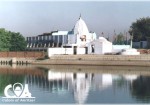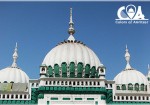Sikhism is a monotheistic religion that follows the teachings of its ten Gurus and the holy book Sri Guru Granth Sahib. In its philosophy, emphasis is not only on an individual’s personal dedication to following the path laid out in these teachings, but also in the congregation called sangat. Though it is important to read the scriptures on your own, it is equally important to regularly visit a gurudwara sahib. The word gurudwara means “gateway to the Guru”. Gurudwaras Sahib are open to people of all religions, castes and races.
Majority of the gurudwaras sahib are situated around or with a sarovar.
SAROVAR (a tank) especially at a sacred place or by a holy shrine used for sacramental ablutions and other religious ceremonies. Sanskrit synonyms are sar, sarvar, tarag and vapl. Another word is puskar or puskarini which usually means a pond full of lotus flowers. The lotus is a symbol of purity; water symbolizes fertility as well as purity. The primary association of sarovar is with the purificatory aspects of its water. In the Sikh sacred literature we find sarvar, sar, sarovar, and mansaused in the sense of a lake or pool. The sanctity of sarovar is often related to that of the place where it exists. It is a bathingplace where bathing has a religious significance.The word sarovar sums up a great deal of water symbolism documented in the religious history of India from the time of the Rgveda to that of the Sri Guru Granth Sahib.
This walk aims to introduce the story of five important sarovars to the visitors and to also give them an insight into the evolution of Sikhism. The walk begins at Sri Santokhsar Sahib Sarovar and moves along the road passing the Gurdwara Saragarhi and Jallianwala Bagh along the way onto the narrow streets to the second stop of the walk; Sri Bibeksar Sahib Sarovar. Then just across the street is the third pit stop of the walk; Sri Ramsar Sahib Sarovar. Then going on the sacred Sri Guru Granth Sahib Marg where pilgrims often walk barefooted in honour of the fifth Guru, Sri Guru Arjan Dev Ji to reach the fourth stop on this walk the Sri Kaulsar Sahib Sarovar before making a small visit to Sri Baba Atal Sahib. Moving along, the walk leads us into the premises of the Sri Harmandir Sahib, passing the langar hall to Ramgarhia Bunga and then to the final and most sacred sarovar, Sri Amrit Sarovar Sahib.
Additional Important Information:
1. Visitors are required to remove their shoes and deposit them at the Joda Ghar (Shoe Bank).
2. Wash your hands and feet before entering the holy place.
3. Keep your head covered at all times. “Scarves to cover your head are available at the
entrance to all the Gurdwaras”.
4. Water is served as a part of volunteer service by devotees within the Holy premises.
5. Read carefully the instructions on photography displayed in different parts of the premises.
6. Enjoy a langar (meal) from the free kitchen.The Langar is run by volunteers doing selfless
service & it is a community kitchen where volunteers prepare and serve food.
The Sikh community contribute towards the Langar in form of cash, grains, pulses, service etc. resulting in strengthening the community feeling.














